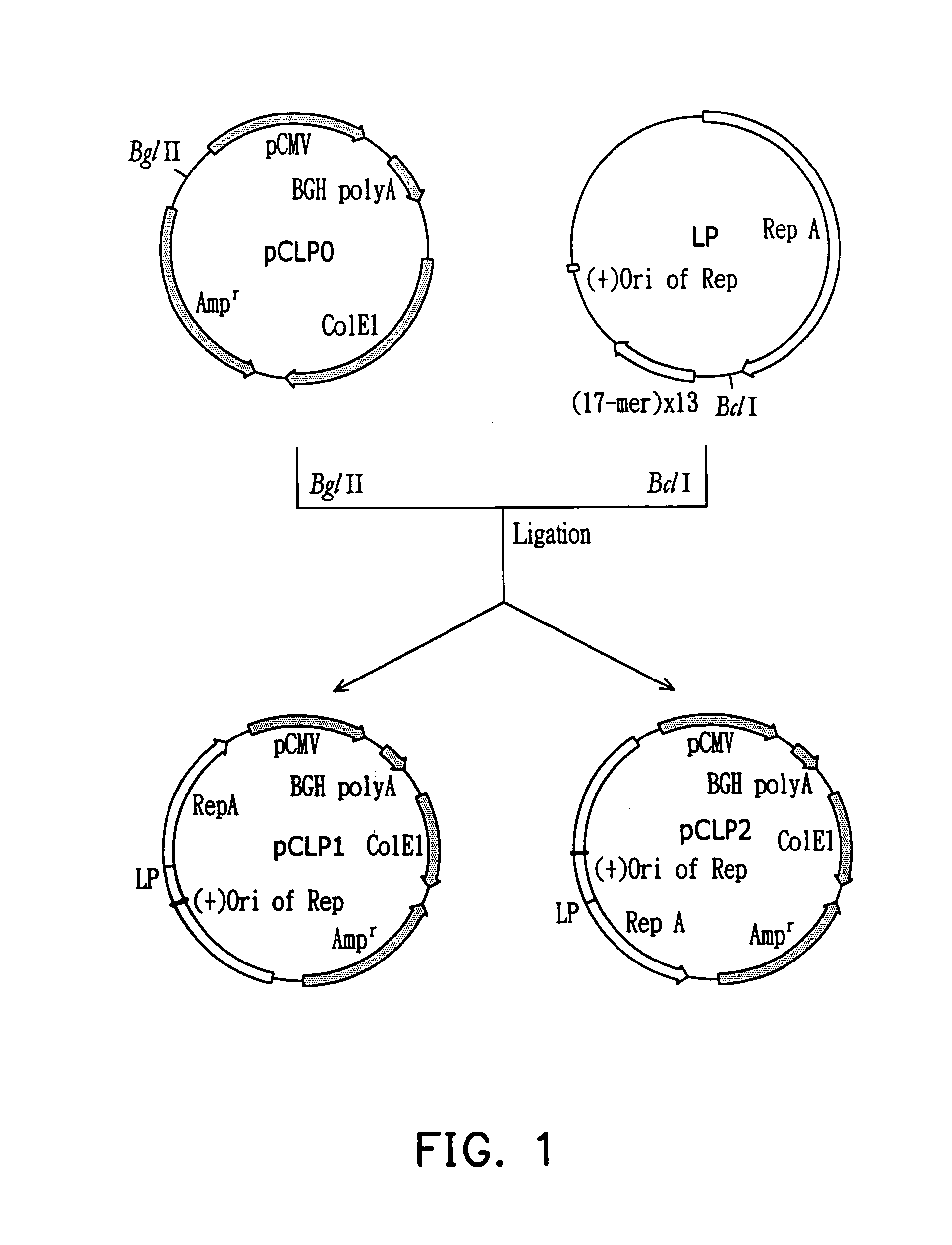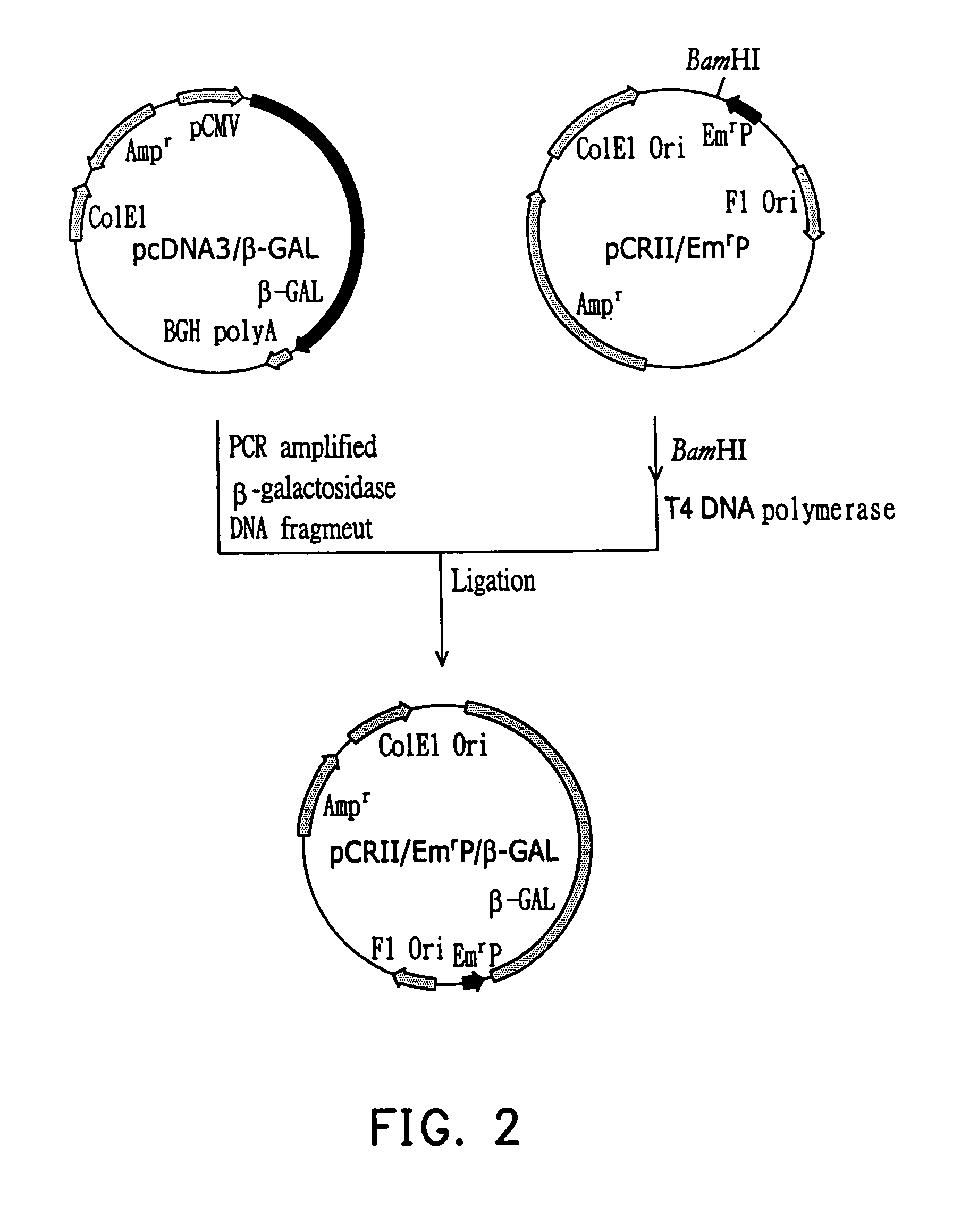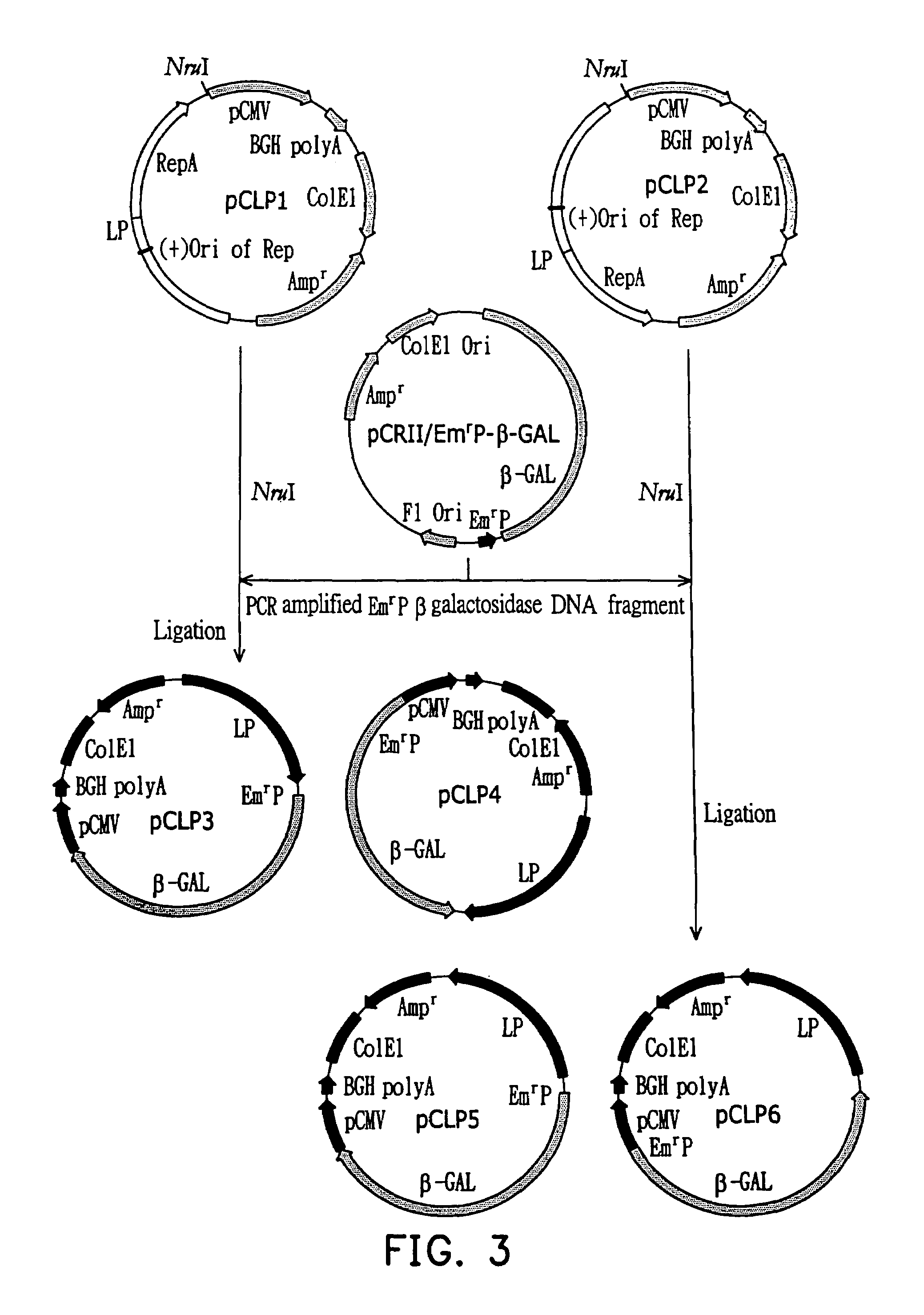Lac shuttle vectors
a shuttle vector and shuttle technology, applied in the field of shuttle vectors, can solve the problems of affecting the immune system affecting the treatment of mammals, and affecting the use of antibiotics, so as to achieve the effect of improving the immunity or health of the organism
- Summary
- Abstract
- Description
- Claims
- Application Information
AI Technical Summary
Benefits of technology
Problems solved by technology
Method used
Image
Examples
example 1
Preparation of Lac− Mutant Host Strain (Ana-1)
[0040]20 μl overnight culture of Lactobacillus casei (subsp. casei) was inoculated to 1 ml MRS broth and incubated at 37° C. for 4 hours. A pellet was obtained by spin-down and then washed twice with PBS buffer (50 mM potassium phosphate, 150 mM NaCl, pH 7.2). The bacterial pellet was resuspended in 0.9 ml PBS buffer and treated with 0.1 ml MNNG stock (N-methyl-N′-nitro-N-nitrosoguanidine; 5 mg / ml in 0.05 M acetic acid). After slow rotation at 37° C. for 1 hour, bacteria were pelleted down and washed three times with PBS buffer, and then resuspended in 0.1 ml MRS broth. Ten-fold serial dilution was performed with MRS broth. 0.1 ml bacteria in MRS from each dilution was spread to a diameter 100 mm agar plate, which has been spread with 40 μl of X-gal (20 mg / ml). These plates were incubated at 37° C. for 1–3 days. White colonies were selected as Lactobacillus casei (subsp. casei) Lac− mutant (Ana-1).
example 2
1. Isolation of Lactobacillus plantarum Plasmid
[0041]Lactobacillus plantarum were collected from 15 ml MRS / overnight cultured broth. The bacteria were lysed with 4.755 ml solution I (6.7% sucrose, 50 mM Tris-HCl pH 7.6, 1 mM EDTA pH 8.0, and 100 μg / ml lysozyme) at 37° C. for 20 min. After addition of 482 μl solution II (50 mM Tris-HCl pH 7.6 and 0.25 M EDTA) and 276 μl solution III (20% SDS, 50 mM Tris-HCl pH 7.6, and 20 mM EDTA), the mixture was incubated at 37° C. for 20 min and vigorously shaken for 30 sec, followed with addition of 1.276 ml of 3 N NaOH and rotation for 10 min, and addition of 496 μl of 2 M Tris and rotation for another 10 min. For extraction of bacterial protein, bacterial lysate were added with 717 μl of 5 M NaCl and 700 μl phenol saturated with 3% NaCl. After centrifugation, the aqueous phase was extracted with equal volume of chloroform-isoamylalcohol (24:1). After mixing and centrifugation, the aqueous phase was precipitated with equal volume of isopropanol ...
example 3
1. Isolation of Chromosomal DNA from Lactobacillus delbrueckii (Subsp. bulgaricus)
[0043]Lactobacillus delbrueckii (subsp. bulgaricus) were collected from 20 ml MRS / overnight cultured broth. The bacterial pellet was resuspended in 1 ml TES buffer (100 mM Tris, 20 mM EDTA, 20% sucrose, and 1 mg / ml lysozyme) at 37° C. for 30 min. The cells were then subjected to five freeze-thaw cycles by freezing in a dry ice-ethanol bath and thawing in a 37° C. water bath. The cells were lysed by addition of ½ volume of 1% SDS (sodium dodecyl sulfate) solution. The chromosomal DNA was purified by triple phenol extractions. The DNA was finally precipitated with ethanol, air dried, and then dissolved in H2O.
2. Cloning of β-galactosidase Gene
[0044]The β-galactosidase gene was amplified from chromosomal DNA of Lactobacillus delbrueckii (subsp. bulgaricus) by polymerase chain reaction (PCR). The PCR amplification consisted of 0.075 units Pfu Turbo™ DNA polymerase (STRATAGENE®, La Jolla, Calif.), 1 μM each...
PUM
| Property | Measurement | Unit |
|---|---|---|
| pH | aaaaa | aaaaa |
| volume | aaaaa | aaaaa |
| volume | aaaaa | aaaaa |
Abstract
Description
Claims
Application Information
 Login to View More
Login to View More - R&D
- Intellectual Property
- Life Sciences
- Materials
- Tech Scout
- Unparalleled Data Quality
- Higher Quality Content
- 60% Fewer Hallucinations
Browse by: Latest US Patents, China's latest patents, Technical Efficacy Thesaurus, Application Domain, Technology Topic, Popular Technical Reports.
© 2025 PatSnap. All rights reserved.Legal|Privacy policy|Modern Slavery Act Transparency Statement|Sitemap|About US| Contact US: help@patsnap.com



